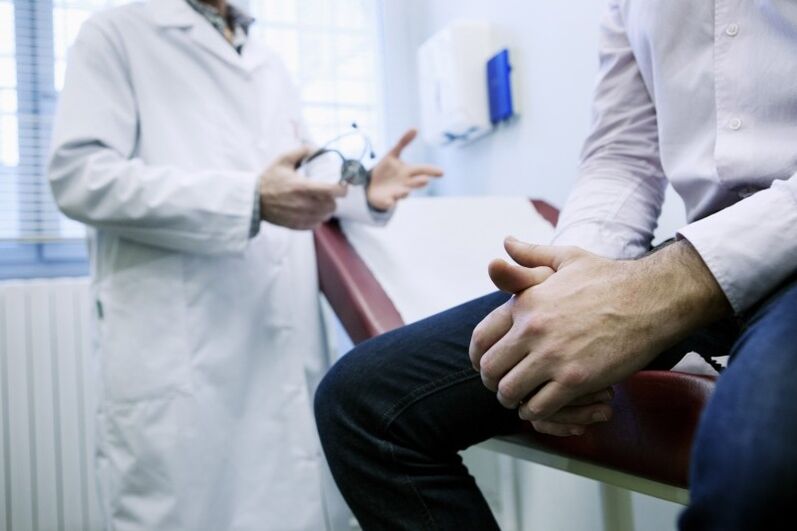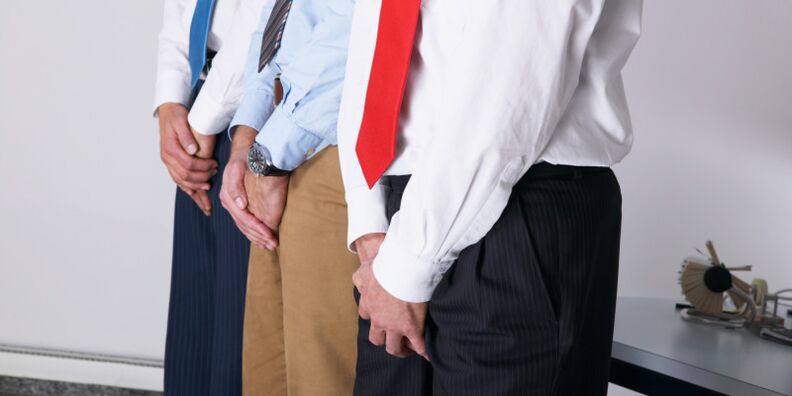
Prostatitis is a terrible disease of the male genital area, which often affects young men under the age of forty. Although its symptoms - decreased sexual desire, difficulty urinating, groin pain - are very painful, males are in no hurry to seek medical help.
And the reason for this is the insufficient amount of information about this disease, there are too many myths and prejudices about it.
However, the manifestations of prostatitis only worsen over time, so at the first signs of prostatitis, it is necessary to urgently contact a qualified urologist.
Causes of prostatitis
Prostatitis is an inflammation of the prostate. Doctors classify the acute stage of the disease and the chronic. If the first is left untreated, then the inflammation quickly becomes chronic and is fraught with many complications, such as impaired sexual function and even the development of a malignant prostate tumor.
What are the reasons for his appearance?
Here are just a few of them:
- Sexually transmitted diseases. Often men are carriers of a specific infection, without even knowing it, since the disease is completely asymptomatic. However, this picture is very misleading. Once the immune system fails, for example, under the influence of a stressful situation, it triggers the development of prostatitis. The most common causative agents of the disease are the herpes virus, the fungus of the genus Candida, Escherichia coli and others.
- Untreated bladder infections. In this case, the infection spreads easily to the nearby prostate gland.
- Stagnation of blood in the pelvic area. This can lead to a sedentary lifestyle, irregular sex life. In this case, there is a so-called non-bacterial prostatitis.
- Regular hypothermia, stress, the presence of infectious foci, including tooth decay, in the body.
- Prostatitis can develop as a complication after serious infectious diseases - flu, tonsillitis and others.
The main symptoms of prostatitis
The most common signs of this disease, regardless of the cause, include:
- power reduction;
- pain and difficulty urinating.
- pain of varying severity in the groin and genitals.
Symptoms of acute bacterial prostatitis
As mentioned above, the first stage of bacterial prostatitis is acute, lasting no more than 3-5 days, after which it slowly turns into years.
It is very important not to miss the first symptoms of the disease:
- Pain in the groin and scrotum.
- Acute pain when urinating.
- Pattern of pain after intercourse in the foreskin of the penis.
- Worsening of the erection, reduction of the duration of sexual intercourse.

A few days after the onset of the first symptoms, the pain subsides, men have the misleading impression that the threat is over. However, this only means that prostatitis develops slowly but steadily over the years.
Such a course of the disease is characterized by:
- Alternating periods of remission and exacerbation of prostatitis.
- Difficulty urinating, frequent urges, feeling of incomplete emptying of the bladder are combined with the above signs of the disease.
During the period of exacerbation of chronic bacterial prostatitis, patients suffer from the same symptoms as in the acute form.
Even seemingly harmless factors can cause it:
- hypothermia;
- Cold;
- An erection that had no awareness.
- Vitamin deficiency?
- Stress and overwork.
- Sedentary life?
- constipation;
- Irregular sex life.
- Smoking and alcohol abuse.
Symptoms of non-bacterial prostatitis
This disease is also called congestive prostatitis. This is the most dangerous and common type of pathology. Its development is directly related to the way of life of modern man.
Doctors compare chronic congestive prostatitis in severity and prevalence with dangerous diseases such as tuberculosis or cancer, because its neglected form is a direct route to prostate cancer.
This form of the disease can be discussed when the inflammation of the prostate was not caused by microorganisms, but by other factors - long absence of sexual intercourse, sedentary lifestyle, regular stressful situations.
Such a conclusion can be drawn from the results of a bacteriological study, which shows the absence of pathogenic microorganisms.
The symptoms of this form of the disease are somewhat different from bacterial:
- Patients complain of periodic or persistent dull pain in the pelvis, lower abdomen, groin, and genitals.
- Sexual dysfunction and problems with urination.
- Depressed mental state of patients
Symptoms of chronic asymptomatic prostatitis

This is a latent form of the disease. As the name implies, it is asymptomatic, ie there is an inflammatory process in the prostate, but this does not affect the patient's condition.
Some medical researchers tend to view this form of pathology only as age-related physiological changes in the prostate gland, which occur due to reduced blood supply to the organ.
This disease is often detected in a patient completely by accident, for example, during an operation on the abdomen associated with a completely different diagnosis.
To avoid prostatitis, you need to know its causes.
Thus, the main measures to prevent inflammation of the prostate gland:
- Although the main measures to prevent prostatitis, as has been mentioned many times, include regular sexual activity, it is still worth avoiding occasional sexual intercourse or the use of barrier contraceptives is imperative. This measure is mandatory, since about 30% of cases of prostate inflammation are associated with sexually transmitted diseases.Alternative sexMasturbation is also welcomed by urologists, as full sexual intercourse improves blood supply to the prostate gland.
- Physical activity, active lifestyle. Physical education and sports are useful as a general measure of strength, but it is worth focusing on exercises that improve blood circulation in the pelvic area. These include running, skating, skiing etc.
- Regular preventive examinations by a urologist or andrologist, at least once a year.
- Early treatment of foci of infection in the body, for example, oral hygiene.
The diagnosis of prostatitis is complex and multifaceted

The diagnosis of prostatitis is mainly related to locating the cause of the disease, it includes the following steps:
- Of great importance for clarifying the picture of the disease is a research of the patient, who must describe in detail his complaints - the identification of certain sensations, their duration, what events are associated with the events and after which they began. Also, at the appointment, the doctor carefully examines the patient's medical record for previously transferred illnesses, examinations, and tests. The urologist clarifies the patient's information about sex life, the presence of sexually transmitted diseases.
- Examination of the smear and abrasion from the urethra. An increased number of white blood cells in a smear and the presence of abnormal microflora in a scraping will indicate the presence of infection.
- General urine analysis. Helps detect the presence of infection, its presence is indicated by an increased number of leukocytes (over 5).
- Ejaculation analysis. It is performed to confirm the diagnosis of non-bacterial prostatitis.
- Prostate ultrasound. It allows you to see the picture of the disease in the most complete way. It is performed to clarify the diagnosis in both acute and chronic inflammation of the prostate, suspected cancer.
Pain and decreased strength - as the first signs of prostatitis
Most of the time, doctors have to deal with an already advanced form of the disease, as most men either tend to ignore the first worrying bells - groin pain and decreased libido, or the disease itself is asymptomatic for some time.
These are the characteristics of male anatomy - in the prostate area, blood circulation is difficult, it is a "nutrient" for the reproduction of pathogenic microorganisms, a sedentary lifestyle significantly aggravates this problem. Therefore, the reason for the massive spread of prostatitis among truck drivers and office workers becomes obvious.
One way or another, up to 50% of the total male population on the planet has never experienced certain symptoms of prostatitis. That's why it is so important to know the first signs of the disease and seek medical help early. After all, treating an advanced form of the disease is a costly and time-consuming task.
Treatment that brings the patient back to full life

Of course, it is much easier to get rid of prostatitis in the early stages than with a neglected disease. However, it is in the chronic form that doctors treat more often and usually requires long-term and complex treatment.
But in any case, you must first determine the main cause of the pathology - stagnation of blood and (or) inflammation in the prostate.
Thus, the complex treatment of prostatitis includes:
- Inflammatory processes are treated with broad-spectrum antibiotics. In addition, the drugs are prescribed both in the form of tablets and in the form of anal suppositories. The infusions of medicinal herbs (chamomile, calendula), which are administered in the form of microcapsules, help the complex well.
- However, the treatment of prostatitis should not be limited to taking medication, it should aim at restoring blood circulation to the prostate area and this includes a set of physiotherapy and therapeutic exercises. Such measures help to better absorb antibacterial drugs, as they improve the blood supply to the prostate gland. Doctors often prescribe for prostatitis: electrophoresis, laser therapy, magnetotherapy.
- Prostate massage. This procedure is useful and effective, but should not be performed at home without consulting a doctor, as it has many contraindications, including the acute phase of the disease.
In summary, the issue of treatment and prevention of prostatitis depends to a large extent on the desire and activity of men themselves. Essential morning exercises, regular preventive examinations by a urologist, balanced diet - this is the key to male strength and longevity!





























